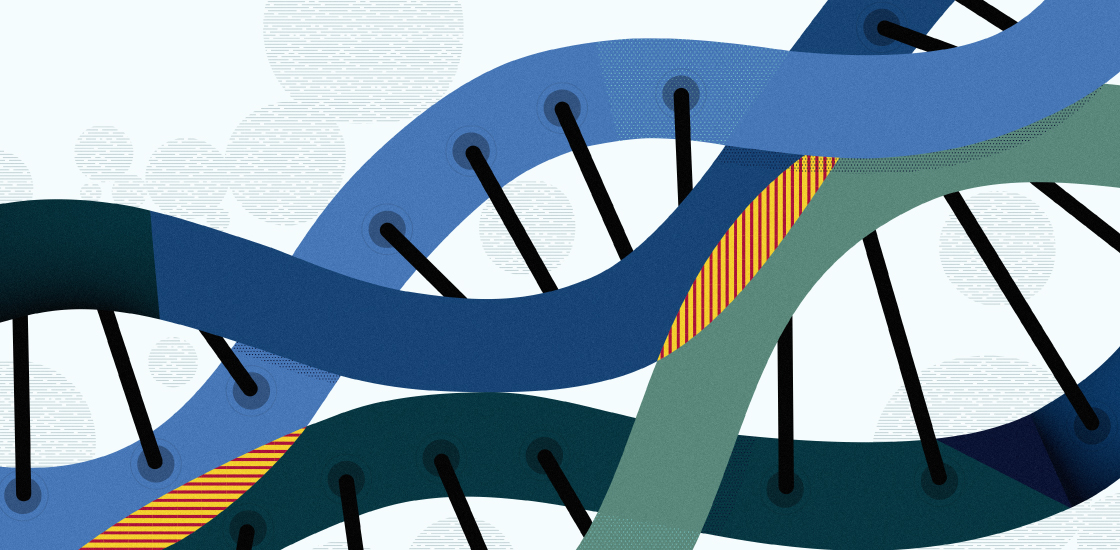Common variants in five regions of the genome distinguish people with autism from those with attention-deficit/hyperactivity disorder (ADHD), and these alterations can have dramatically opposite effects on brain volume and other traits, a new study finds. Common variants in seven other regions are shared between the two conditions.
People with co-occurring autism and ADHD have more of these common variants than do those with either condition by itself, suggesting that the combined diagnosis — introduced in 2013 — may deserve to be its own category, one that is significantly different from either autism or ADHD alone, the researchers say.
“Our results provide novel insights into the genetic architecture and biological foundation for developing just one or both of the disorders,” says Anders Børglum, professor of biomedicine at Aarhus University in Denmark, who led the study. And they advance researchers “towards the long-term goals of better diagnosis and treatment of these conditions.”
Although autism and ADHD differ from each other in terms of core traits, previous research has hinted at a significant genetic overlap: Both conditions tend to run in families, and 25 to 32 percent of autistic people have ADHD, according to a 2019 study.
Scientists have long debated whether autism and ADHD represent distinct conditions or one condition along a single continuum of severity, says Geraldine Dawson, professor of psychiatry and behavioral sciences at Duke University in Durham, North Carolina, who did not take part in this work.
“This study provides compelling evidence that autism and ADHD are distinct genetic conditions that share some components of genetic risk,” she says. “People diagnosed with both autism and ADHD represent a distinct clinical entity,” and therapeutic approaches for them “need to simultaneously address both conditions — and consider how having both conditions also results in unique challenges.”
B
ørglum’s team conducted a genome-wide association study — focused on 8.9 million common single-letter changes — in 34,462 people with autism, ADHD or both, as well as 41,201 controls, from the Psychiatric Genomics Consortium and the Lundbeck Foundation Initiative for Integrative Psychiatric Research (iPSYCH).Seven genetic regions, or loci, harbor common variants found in people with autism, ADHD or both conditions but not controls, the researchers found, including two regions that prior work analyzing the same data had overlooked. All these shared loci are strongly associated with psychiatric conditions such as depression, the scientists note.
Five other loci carry variants that can set the two conditions apart, based on a comparison of 9,315 people with autism only and 11,964 people with ADHD only. Four of these regions escaped earlier analyses in search of differences.
A different subset of four of these five loci are strongly associated with cognitive traits, such as educational attainment, neuroticism, the size of certain brain regions, years of schooling and childhood IQ. Variants within these loci had opposite effects in the two conditions.
For example, an autism-linked variation in the histone gene cluster HIST1 on chromosome 6 also correlates with increased cognitive performance and a larger-than-average left globus pallidus, a brain region associated with voluntary movement. By contrast, a different ADHD-linked HIST1 variation is associated with decreased cognitive performance and a smaller-than-average left globus pallidus.
Børglum and his colleagues detailed their findings online 26 September in Nature Genetics.
P
eople who have both autism and ADHD are often thought to have more of one condition than the other, Dawson says. But the new study found that these people possess genetic traits for both conditions.The genetic differences between autism and ADHD endorse the change in the fifth edition of the Diagnostic and Statistical Manual of Mental Disorders to permit, for the first time, diagnoses of both conditions in the same person, Børglum says.
A long-term goal of psychiatric genetics “is to provide data that can be used to develop more biologically informed diagnoses,” says Jan Haavik, professor of biomedicine at the University of Bergen in Norway, who was not involved in this work. “This study could be a step in this direction,” for instance, by dividing autism from one condition into multiple genetic categories.
One drawback of the new analysis is that it considered people with only European genetic ancestry, Børglum says. “In future studies, we expect to have many more samples with diverse ancestries,” as well as larger sample sizes, to better elucidate how these findings might apply to autistic people in general.
The study is also limited because it focused exclusively on common genetic variants, says Jonathan Sebat, director of the Beyster Institute for Psychiatric Genomics at the University of California, San Diego, who did not take part in this research. “It’s well-known that autism has a substantial contribution from rare variants, and these could also be factors that discriminate autism spectrum disorder and ADHD.”
Future work might consider common and rare variants at once. Also, when Børglum and his colleagues investigated the loci where autism and ADHD differ, they looked only at people either condition. Future research can examine what is happening at these loci in people with both autism and ADHD, Børglum says, although he suspects that at these loci, they are genetically similar to people without either condition.





